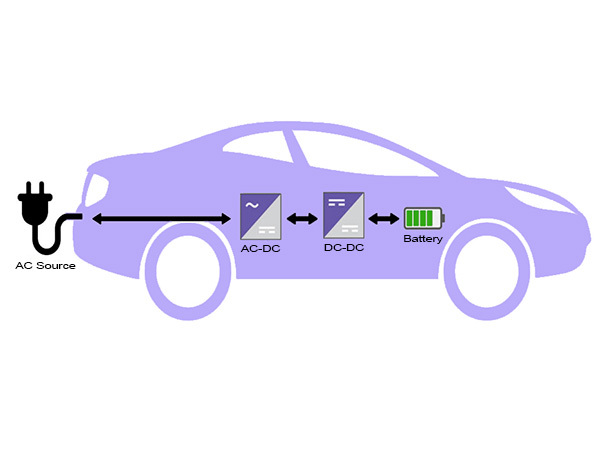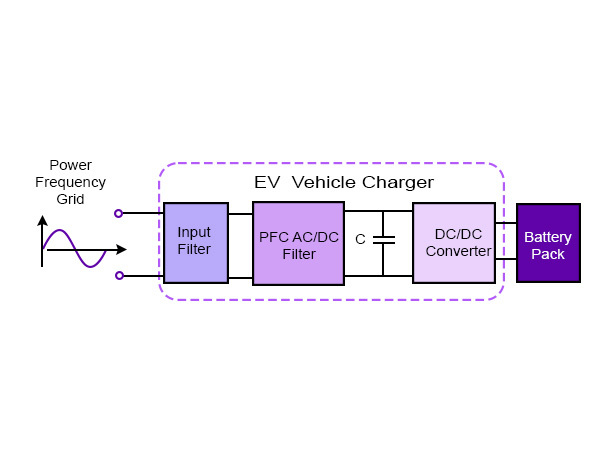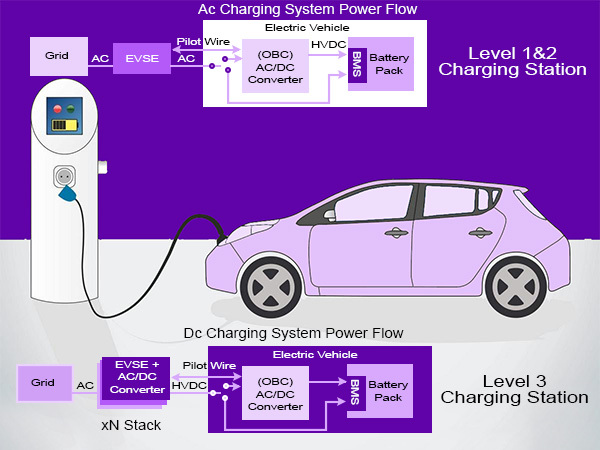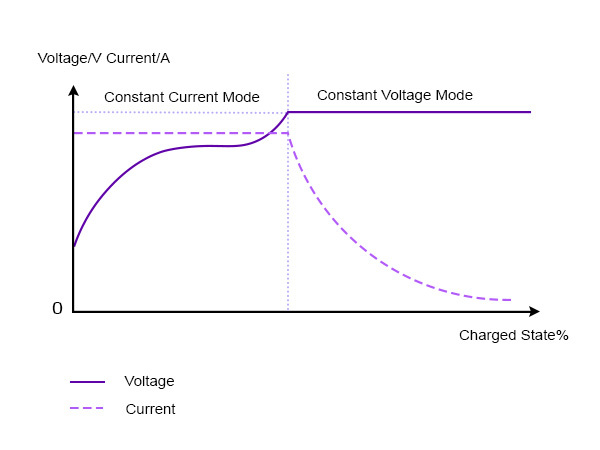On board charger is power electronic devices that are designed to recharge the batteries of electric vehicles (EVs) from the electric grid, while the vehicle is in parking. They are integrated into the vehicles and play a crucial role in ensuring that the batteries have sufficient charge for driving. They can be connected to an external power source to recharge the vehicle's battery and the capacity and technology of onboard charger can vary depending on the type of electric vehicle.

The on board charger have many applications apart from charging the batteries of an EV. They are most commonly used in:
Hybrid electric vehicles (HEVs): Onboard chargers are used to charge the battery in hybrid electric vehicles, helping to extend the electric-only driving range of the vehicle.
Industrial equipment: Onboard chargers are used in a variety of industrial equipment, such as material handling equipment, forklifts, and aerial work platforms, to recharge the battery when the equipment is not in use.
Marine applications: Onboard chargers are used in marine applications, such as boats and yachts, to recharge the battery while the vessel is docked.
Portable power: Onboard chargers are used in portable power applications, such as portable generators, to recharge the battery when the generator is not in use.
Renewable energy systems: Onboard chargers are used in renewable energy systems, such as solar and wind power systems, to recharge the battery when the renewable energy source is not generating power.

Features of an onboard charger depend on the type of vehicle and also the kind of charging station it is optimized for. However, a typical onboard charger is designed keeping the below-mentioned key features in mind.
Power capacity: On-board chargers come in different power capacities, ranging from 3 kW to 22 kW. This means that the time it takes to fully charge the battery will depend on the power capacity of the charger.
Charging modes: Some onboard chargers can charge the battery at a constant current or constant voltage or using a combination of both modes. Some advanced chargers can also support fast charging modes, allowing the battery to be charged to 80% in as little as 30 minutes.
Communication: Most onboard chargers support communication protocols like the CAN bus, which enables communication with the vehicle's battery management system and charging station.

The architecture of an onboard charger is designed to ensure that the battery is charged safely, efficiently, and in a way that optimizes its performance and lifespan. It typically consists of several stages that work together to convert AC power from the charging station into a form that can be used to charge the vehicle's battery. It consists of three stages, the input stage, the BMS, and the communication stage. The components used in an on-board charger are determined by the architecture used for the design of the onboard charger and may vary from one model to another, but they typically include:
Power Conversion Unit: Converts the AC power from the external source into DC power that is suitable for charging the battery.
BMS (Microprocessor and Control Unit): Monitors, manages, and regulates the charging process, including voltage and current regulation, temperature monitoring, and fault protection. Also manages communication with the charging station, and provides user interface functionality.
Connectors: Used to connect the charger to the vehicle's battery and the external power source.
Transformers: Steps down the voltage from the charging station to a level that is safe and usable for the battery.
Power Electronics: Used to control the flow of electricity into the battery and to protect against overcharging and overheating.
Filters: Used to remove any noise or interference from the power supply
Sensors: Sensors, such as voltage sensors and current sensors, are used to measure the battery's voltage and current, and provide feedback to the microcontroller.
Actuators: Actuators, such as switches and relays, are used to control the power electronics and regulate the charging process.
Cooling System: Used to dissipate heat generated during the charging process.
Display or indicator lights: Show the charging status and other information about the charging process.
To understand the working of an onboard charger, it is essential to first understand how the BMS is designed and works for an onboard charger. The battery management system (BMS) of an onboard charger is an essential component that plays a critical role in ensuring the safety and efficiency of the battery charging process. It is crucial to optimize the safety, lifespan, and performance of any battery-operated device. The BMS performs several functions, including monitoring the battery's state of charge, voltage, current, and temperature, and managing the charging process to ensure the battery is charged safely and efficiently. It works in the following stages:
Data acquisition: This stage involves collecting data from various sensors and monitoring the battery's state of charge, voltage, and temperature.
Data processing: The collected data is processed to determine the battery's state of charge, voltage, and temperature. The processed data is then used to control the charging process.
Charging algorithm and control: The BMS controls the amount of current and voltage supplied to the battery during the charging process. It regulates the charging process, charging rate, and timing based on the battery's state of charge, temperature, and other parameters to ensure the battery is charged safely and efficiently.
Safety protection: The BMS includes safety protection functions to ensure that the charging process is safe, even in the event of a fault or failure. If any issues are detected, it can interrupt the charging process to prevent damage to the battery or other components.
Communication: The BMS communicates with the charging station and the control and communication unit of the onboard charger to monitor the charging process and provide user interface functionality. On-board chargers use communication protocols, such as the Charging Interface Initiative (CHAdeMO) or the Combined Charging System (CCS), to communicate with the charging station and negotiate the charging parameters.
Power distribution: On board charger use power distribution systems to manage the distribution of power between the vehicle's systems and the battery, to ensure that the vehicle can continue to be driven while charging.
Data logging: The BMS records data about the battery's state of charge, voltage, temperature, and the charging process, which can be used for analysis and maintenance purposes.
The control system/unit is one of the most critical units of the BMS of an onboard charger. The lifespan of the battery and overall protection of the EV depends heavily on the control system. Failure of the control unit can lead to catastrophic results. The charger offers either constant current or constant voltage charging, both of which are easy to operate. And each of them has its advantages and disadvantages. In the case of constant current charging, there is high efficiency and charging speed, but there is a risk that the battery will be overcharged at a later stage, and its lifespan reduced. In the case of constant voltage charging, there is a risk that too much current will flow into the battery from the beginning, which will heat the battery too much and shorten its lifespan again. Typically, a combination of both modes is used. This process can be explained by the graph shown below:
The charger ensures that it is initially charged with a constant current, thus maintaining speed and efficiency, and when the voltage at both ends of the battery reaches a certain amplitude, it changes to constant voltage charging. This system is called the charging strategy and it is the most important function of the onboard charger. Other control loops work simultaneously along the current and voltage loops like the temperature control loop, which regulates the temperature of the battery by monitoring the battery temperature and controlling the charging process accordingly. The temperature control loop ensures that the battery is charged within a safe temperature range, which is known to be optimal for the battery thereby avoiding explosions and breakdown.
The BMS also includes multiple safety measures apart from overvoltage, overcurrent, and thermal protection to prevent possible faults or failures. Some of them are mentioned below:
Short circuit protection: Protects against short circuits that could damage the battery or other components.
Ground fault protection: Protects against ground faults that could cause electrical shock or damage to the battery or other components.
Reverse polarity protection: Protects against reverse polarity connections that could damage the battery or other components.
All the above safety measures are critical in ensuring the reliability and longevity of a battery.
Next:Safety Checklist for Forklift Battery Charging Areas
Previous:Charging Li-ion Battery For Forklifts
Contact Person: Miss. Kiki
| WhatsApp : | +8617763224709 |
|---|---|
| Skype : | +8617763224709 |
| WeChat : | +8617763224709 |
| Email : | kiki@lifepo4-battery.com |